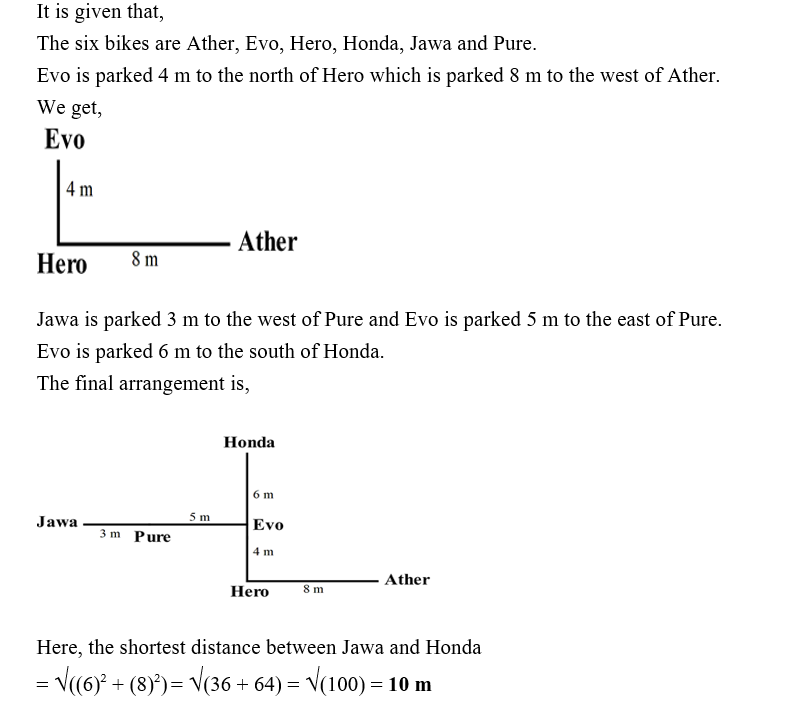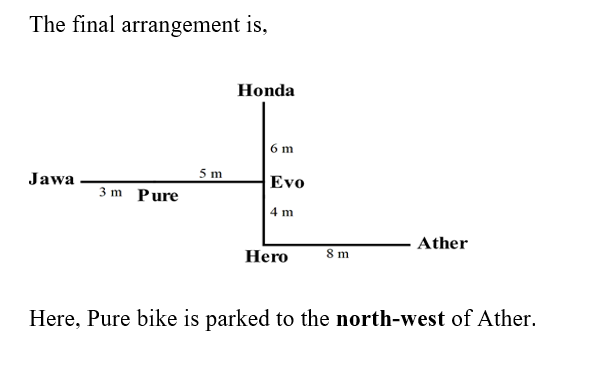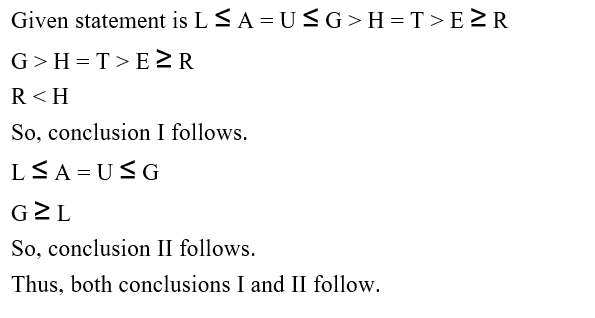Question 1:
Directions : Study the given information and answer the following questions based on it.
निर्देश : दी गई सूचना का अध्ययन कीजिए और उसके आधार पर निम्नलिखित प्रश्नों के उत्तर दीजिए।
In a certain code,
"Prince is wearing crown" is coded as "q6f j2t x7h d5o"
"Court crown and public" is coded as "d5u d5o b3e q6d"
"Mercy is court decision" is coded as "n5z j2t d5u e8o"
"Live and let live" is coded as "m4f b3e m3u m4f"
एक निश्चित कोड में,
"Prince is wearing crown" को "q6f j2t x7h d5o" के रूप में कोडित किया गया है।
"Court crown and public" को "d5u d5o b3e q6d" के रूप में कोडित किया गया है।
"Mercy is court decision" को "n5z j2t d5u e8o" के रूप में कोडित किया गया है।
"Live and let live" को "m4f b3e m3u m4f" के रूप में कोडित किया गया है।
What is the code for "Crown"?
"Crown" के लिए कोड क्या है?
Question 2:
Directions : Study the given information and answer the following questions based on it.
निर्देश : दी गई सूचना का अध्ययन कीजिए और उसके आधार पर निम्नलिखित प्रश्नों के उत्तर दीजिए।
In a certain code,
"Prince is wearing crown" is coded as "q6f j2t x7h d5o"
"Court crown and public" is coded as "d5u d5o b3e q6d"
"Mercy is court decision" is coded as "n5z j2t d5u e8o"
"Live and let live" is coded as "m4f b3e m3u m4f"
एक निश्चित कोड में,
"Prince is wearing crown" को "q6f j2t x7h d5o" के रूप में कोडित किया गया है।
"Court crown and public" को "d5u d5o b3e q6d" के रूप में कोडित किया गया है।
"Mercy is court decision" को "n5z j2t d5u e8o" के रूप में कोडित किया गया है।
"Live and let live" को "m4f b3e m3u m4f" के रूप में कोडित किया गया है।
Based on the above information what is the code for "Jungle"?
उपर्युक्त सूचना के आधार पर "Jungle" का कोड क्या है?
Question 3:
Directions : Study the given information and answer the following questions based on it.
निर्देश : दी गई सूचना का अध्ययन कीजिए और उसके आधार पर निम्नलिखित प्रश्नों के उत्तर दीजिए।
In a certain code,
"Prince is wearing crown" is coded as "q6f j2t x7h d5o"
"Court crown and public" is coded as "d5u d5o b3e q6d"
"Mercy is court decision" is coded as "n5z j2t d5u e8o"
"Live and let live" is coded as "m4f b3e m3u m4f"
एक निश्चित कोड में,
"Prince is wearing crown" को "q6f j2t x7h d5o" के रूप में कोडित किया गया है।
"Court crown and public" को "d5u d5o b3e q6d" के रूप में कोडित किया गया है।
"Mercy is court decision" को "n5z j2t d5u e8o" के रूप में कोडित किया गया है।
"Live and let live" को "m4f b3e m3u m4f" के रूप में कोडित किया गया है।
The word "Decision" is coded as _____.
शब्द "Decision" को _____ के रूप में कोडित किया गया है।
Question 4:
Directions : Study the given information and answer the following questions based on it.
निर्देश : दी गई सूचना का अध्ययन कीजिए और उसके आधार पर निम्नलिखित प्रश्नों के उत्तर दीजिए।
In a certain code,
"Prince is wearing crown" is coded as "q6f j2t x7h d5o"
"Court crown and public" is coded as "d5u d5o b3e q6d"
"Mercy is court decision" is coded as "n5z j2t d5u e8o"
"Live and let live" is coded as "m4f b3e m3u m4f"
एक निश्चित कोड में,
"Prince is wearing crown" को "q6f j2t x7h d5o" के रूप में कोडित किया गया है।
"Court crown and public" को "d5u d5o b3e q6d" के रूप में कोडित किया गया है।
"Mercy is court decision" को "n5z j2t d5u e8o" के रूप में कोडित किया गया है।
"Live and let live" को "m4f b3e m3u m4f" के रूप में कोडित किया गया है।
Based on the given information, what is the possible code for "Happy Journey"?.
दी गई सूचना के आधार पर, "Happy Journey" के लिए संभावित कोड क्या है?
Question 5:
In the question given below, two statements are given followed by conclusions: I, II and III. You have to take the given statements to be true even if they seem to be at variance from commonly known facts. Read the conclusions and decide which of the given conclusions logically follows from the given statements disregarding commonly known facts.
नीचे दिए गए प्रश्न में, दो कथन का अनुसरण करते हुए निष्कर्ष I, II और III दिए गए हैं। आपको दिए गए कथनों को सत्य मानना है, भले ही वे सामान्यतः ज्ञात तथ्यों से भिन्न प्रतीत होते हों। निष्कर्षों को पढ़ें और तय करें कि दिए गए निष्कर्षों में से कौन सा दिए गए कथनों का तार्किक रूप से अनुसरण करता है, सामान्यतः ज्ञात तथ्यों की अवहेलना करता है।
Statements: / कथनः
Only a few rules are countries. / केवल कुछ रूल्स, कन्ट्रीज हैं।
All kings are rules. / सभी किंग, रूल्स हैं।
Conclusions: / निष्कर्षः
I. Some rules are definitely not countries. / कुछ रूल्स निश्चित रूप से कन्ट्रीज नहीं है।
II. At least some kings are countries. / कम-से-कम कुछ किंग, कन्ट्रीज हैं।
III. No country is a king. / कोई कन्ट्रीज, किंग नहीं है।
Question 6:
In the question given below, three statements are given followed by three conclusions. You have to take the given statements to be true even if they seem to be at variance from commonly known facts. Read the conclusions and decide which of the given conclusions logically follows from the given statements disregarding the commonly known facts.
नीचे दिए गए प्रश्न में तीन कथन और उसके बाद तीन निष्कर्ष दिए गए हैं। आपको दिए गए कथनों को सत्य मानना है, भले ही वे सर्वज्ञात तथ्यों से भिन्न प्रतीत होते हों। निष्कर्षों को पढ़िए और निर्धारित कीजिए कि दिए गए निष्कर्षों में से कौन-सा निष्कर्ष सामान्य रूप से ज्ञात तथ्यों की अवहेलना करते हुए दिए गए कथनों का तार्किक रूप से अनुसरण करता है।
Statements: Some dimes are dogs. / कुछ डाइम, डॉग हैं।
No dog is a store. / कोई डॉग, स्टोर नहीं है.
All stores are mines. / सभी स्टोर, माइन हैं।
Conclusions: / निष्कर्षः
I. Some mines are dimes. / कुछ माइन, डाइम हैं।
II. Some stores are dimes. / कुछ स्टोर, डाइम हैं।
III. No mine is a dime. / कोई माइन, डाइम नहीं है।
Question 7:
Directions : Six bikes viz. Ather, Evo, Hero, Honda, Jawa and Pure are parked at a certain distance from each other. Evo is parked 6 m to the south of Honda. Jawa is parked 3 m to the west of Pure and Evo is parked 5 m to the east of Pure. Evo is parked 4 m to the north of Hero which is parked 8 m to the west of Ather.
निर्देश : छह बाइक एथर, ईवो, हीरो, होंडा, जावा और प्योर एक दूसरे से एक निश्चित दूरी पर खड़ी हैं। ईवो, होंडा के दक्षिण में 6 m की दूरी पर खड़ी है। जावा, प्योर के पश्चिम में 3 m की दूरी पर और ईवो, प्योर के पूर्व में 5 m की दूरी पर खड़ी है। इवो, हीरो के उत्तर में 4 m की दूरी पर खड़ी है और हीरो, एथर के पश्चिम में 8 m की दूरी पर खड़ी है।
What is the shortest distance between Jawa and Honda?
जावा और होंडा के बीच की न्यूनतम दूरी कितनी है?
Question 8:
Directions : Six bikes viz. Ather, Evo, Hero, Honda, Jawa and Pure are parked at a certain distance from each other. Evo is parked 6 m to the south of Honda. Jawa is parked 3 m to the west of Pure and Evo is parked 5 m to the east of Pure. Evo is parked 4 m to the north of Hero which is parked 8 m to the west of Ather.
निर्देश : छह बाइक एथर, ईवो, हीरो, होंडा, जावा और प्योर एक दूसरे से एक निश्चित दूरी पर खड़ी हैं। ईवो, होंडा के दक्षिण में 6 m की दूरी पर खड़ी है। जावा, प्योर के पश्चिम में 3 m की दूरी पर और ईवो, प्योर के पूर्व में 5 m की दूरी पर खड़ी है। इवो, हीरो के उत्तर में 4 m की दूरी पर खड़ी है और हीरो, एथर के पश्चिम में 8 m की दूरी पर खड़ी है।
What is the direction of Pure bike with respect to Ather?
एथर के सन्दर्भ में प्योर बाइक कौन-सी दिशा में खड़ी है?
Question 9:
Directions : Six bikes viz. Ather, Evo, Hero, Honda, Jawa and Pure are parked at a certain distance from each other. Evo is parked 6 m to the south of Honda. Jawa is parked 3 m to the west of Pure and Evo is parked 5 m to the east of Pure. Evo is parked 4 m to the north of Hero which is parked 8 m to the west of Ather.
निर्देश : छह बाइक एथर, ईवो, हीरो, होंडा, जावा और प्योर एक दूसरे से एक निश्चित दूरी पर खड़ी हैं। ईवो, होंडा के दक्षिण में 6 m की दूरी पर खड़ी है। जावा, प्योर के पश्चिम में 3 m की दूरी पर और ईवो, प्योर के पूर्व में 5 m की दूरी पर खड़ी है। इवो, हीरो के उत्तर में 4 m की दूरी पर खड़ी है और हीरो, एथर के पश्चिम में 8 m की दूरी पर खड़ी है।
If Yezdi is parked 5 m to the west of Honda, then what is the shortest distance between Yezdi and Pure ?
यदि येज़्दि, होंडा के पश्चिम में 5 m की दूरी पर खड़ी है, तो येज़्दि और प्योर के बीच की न्यूनतम दूरी कितनी है?
Question 10:
In the question below, a statement is followed by two conclusions based on the statement. Study the conclusions and select the correct option as the answer.
नीचे दिए गए प्रश्न में, एक कथन के बाद कथन के आधार पर दो निष्कर्ष दिए गए हैं। निष्कर्षों का अध्ययन करें और उत्तर के रूप में सही विकल्प का चयन करें।
Statement: / कथनः L ≤ A = U ≤ G > H = T > E ≥ R
Conclusion: / निष्कर्ष
I. R < H II. G ≥ L






